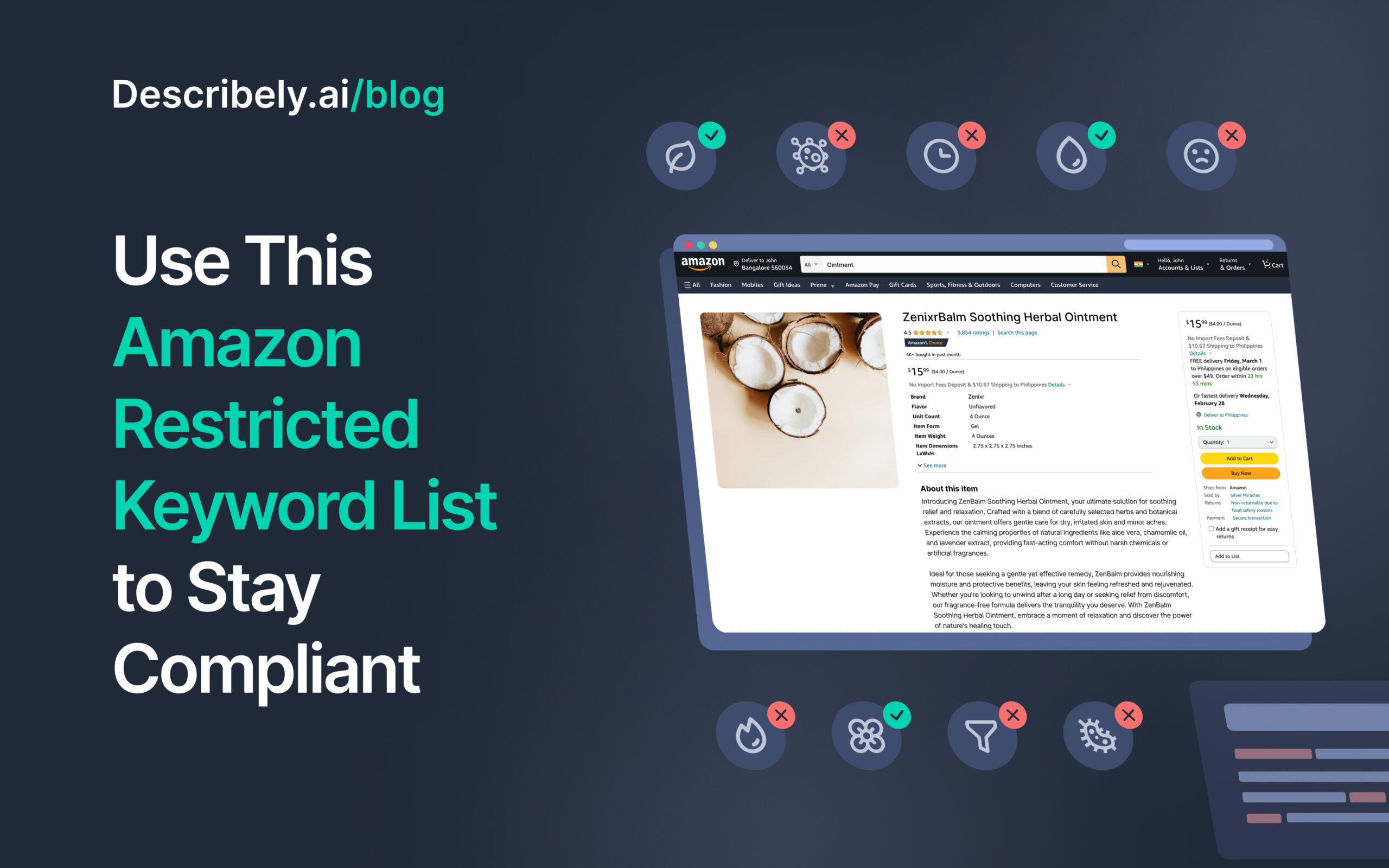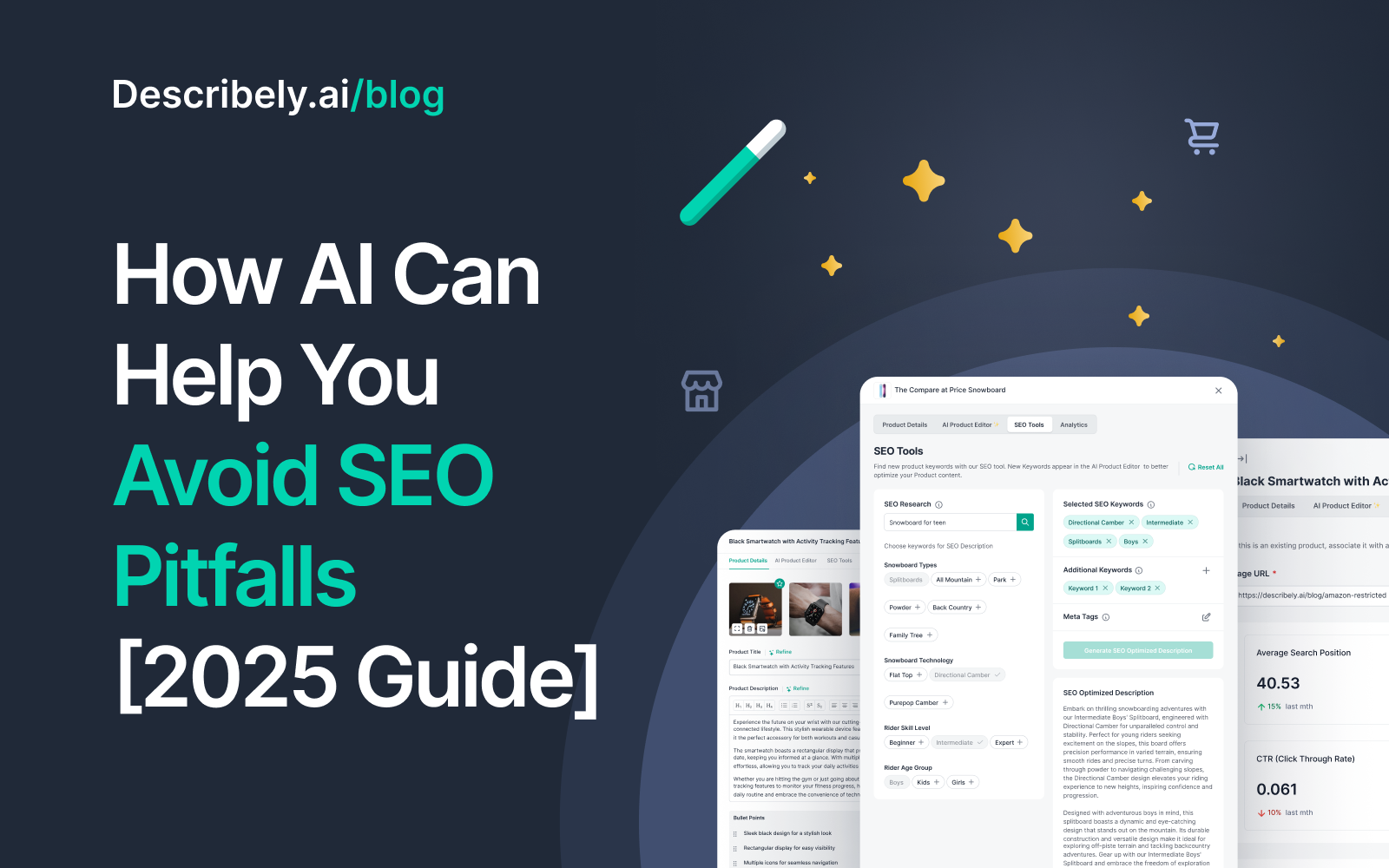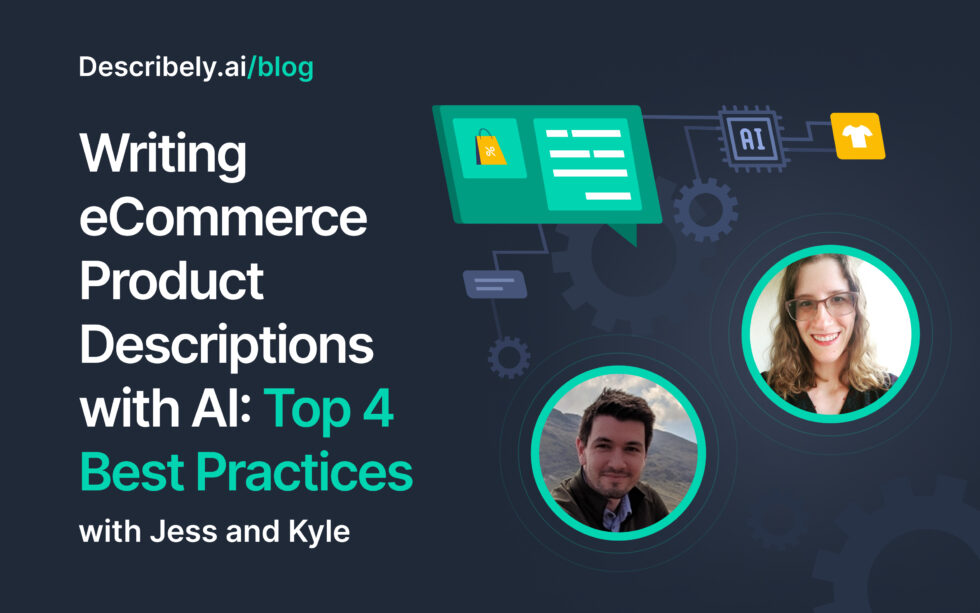
Writing eCommerce Production Descriptions with AI: Top 4 Best Practices
Most eCommerce product descriptions simply don’t cut it.
A recent study by the Nielsen Norman Group found that 20% of unsuccessful purchases can be attributed to a lack of information in product descriptions.
And if you’re part of a big retail or eCommerce operation, dealing with hundreds or even thousands of products, crafting appealing descriptions becomes a real challenge.
But don’t sweat it—AI is here to lend a hand.
So, how exactly can you use AI to whip up product descriptions that sell? And, more importantly, how can you follow the eCommerce product description best practices efficiently at scale?
To get answers to these burning questions, we had a chat with Kyle Neipp and Jess Curcio from the Customer Experience team at Describely.ai.
Kyle and Jess are in the trenches every day, assisting customers with their AI-driven eCommerce needs. They’ve worked closely with eCommerce stores like Borsheims and retail giants like Target AU. This hands-on experience means they’re familiar with the unique intricacies of eCommerce.
And they’ve got some insights to share on how AI can be your secret weapon in creating spot-on product descriptions without the need for endless editing. Let’s dive right in!
What Makes a Great Product Description?
Most AI generators can write product descriptions that are good enough to fill the page. But if your goal is to optimize for sales, then your first step is to identify the properties of a high-converting product description.
Without this step, you simply won’t know what needs the most improvement.
Here’s what you can expect from the following eCommerce product description best practices:
- They consistently follow your brand voice across hundreds of listings
- Even for dozens of minor variations, each description sounds unique
- They’re optimized for high-converting keywords and also exclude the troublesome ones
- They’re informative yet concise, even with sparse product details
- They’re easily adapted to different eCommerce platforms and their format requirements
- They’re accurate and match compliance requirements
A great product description presents all the essential information while compelling users to buy with its brand voice and benefits. And these AI best practices will help you go from good to great.
The Challenges of Using AI for Product Descriptions
AI has the potential to be a total game-changer, especially when it comes to boosting efficiency.
But let’s not sugarcoat it; if you’re not using AI the right way, you’re in for a bumpy ride.
That’s why we asked Kyle and Jess about the common pitfalls or challenges they see eCommerce managers running into when using AI to generate product descriptions, and how they can be avoided.
Jess told us:
“It’s easy to expect AI to be a magic bullet when writing product descriptions. Meaning, they think AI is going to write a perfect description 100% of the time and aren’t prepared to review or tweak to meet their needs.”
Without this expectation, you’re taking the risk of having errors that lead to customer returns— or worse, listing suspensions.
The good news is, you can influence how much editing you’ll need. As Kyle pointed out:
“AI isn’t flawless, and it excels at creativity over getting factual details correct. Find an AI tool that understands this problem and makes your review process quick and painless.”
This leads to the second challenge of generating product descriptions. Kyle also noted:
“Every AI tool is different. The UI, the engine powering it, & the prompts directing it. This means not every tool can create content specifically for products equally.”
If overlooked, you might waste a lot of time and effort optimizing the wrong AI tool. Even if it works, the result is a complex, rigid prompt that won’t work consistently enough for hundreds of products.
Jess agreed:
“This can be avoided by choosing an AI platform that not only captures your product’s unique features and benefits but communicates them back to your audience in a personal, meaningful way. Take advantage of any customization options available, so you can do as little manual editing as possible. “
Using generic AI tools for product descriptions is similar to pasting a Woocommerce description directly to an Amazon listing. The keywords and guideline strictness will change. That’s in fact the third challenge that Jess observed:
“If they’re on Amazon for example, they need to adhere to strict formatting guidelines, and most AI tools simply don’t offer much flexibility.”
Not only does the template change, but it can negatively affect your organic ranking and trigger deactivations. By contrast, Describely can import content from multiple eCommerce platforms and export on their native format.
Now that you’re aware of the challenges (edit expectations, AI specialization, format requirements), Kyle and Jess share how to overcome them efficiently and make the most out of AI content generation.
Best Practices for Writing Product Descriptions With AI
To find the best practices according to the CX team, we asked Kyle and Jess questions like:
- How can Describely users get the most out of AI for product descriptions?
- How do you ensure that hundreds of descriptions remain consistent yet unique?
- How to write a product description that sells?
- What should a product description include?
- How to write a good description for a product due for update?
- How can AI be tailored to fit specific channel guidelines?
- What strategies can help AI avoid redundant, jargon-filled content?
- What’s the most efficient way to generate descriptions for a huge inventory without heavy editing?
Below are their insights organized in four different areas:
- How to write a good product description
- Best practices for updating descriptions
- How to optimize for keywords (including negative ones)
- How to efficiently generate product content at scale
How to Write Product Descriptions With Sparse Product Details
When managing hundreds of products, it’s not uncommon that some of them lack information from suppliers. And some products are too simple to come up with a compelling 150-word+ description.
In both cases, there’s a faster way.
Only with product names, AI can generate full-fledged descriptions. However as Kyle pointed out:
“Describely works magic with only a product title, but you’ll see even better results when you include basic information like product category, features, dimensions, and materials.”
E.g., Even if specifications (e.g. weight) aren’t part of the product description copywriting, you can add them to your prompt to generate the benefits that they represent.
But what if you can’t be more detailed in your product instructions? That doesn’t mean your generator can’t be more resourceful. Kyle added:
“Customization is at the heart of Describely because we know brand voice is important. AI Rules let you take an “out of the box” solution and tailor it to your businesses specific needs.”
So the more thorough you are at setting AI rulesets, the easier it is to compensate for insufficient product information. For example, these are the default Describely rules:
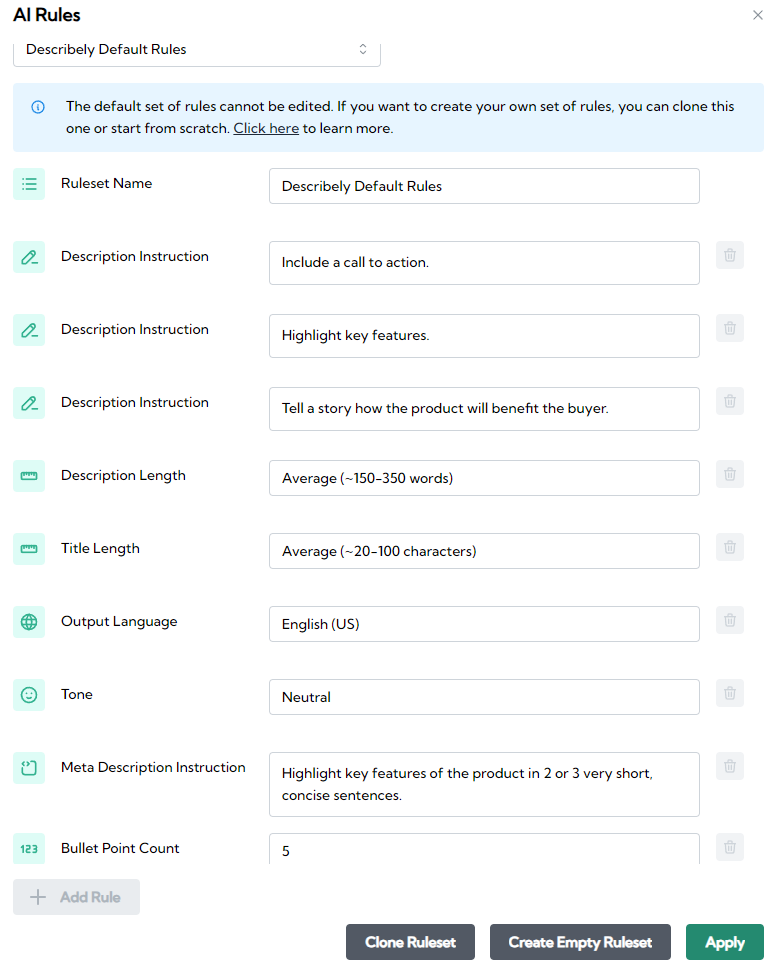
And here’s a product description generated only with the title:

Note. This is an online store description sample covered more in-depth in our other post: “What’s the Best Product Description Generator for eCommerce?”
Notice how Describely fills in the blanks. As long as you review for factual mistakes, it’s more than enough for a new listing to stand out from competitors and even minor variations.
Remember, the less information you use, the more likely it is to sound repetitive and vague. According to Kyle, there’s another way to mitigate it:
“AI excels at creativity so this problem is expected, but doesn’t make it easy to keep content short and factual. The key here is to find an AI tool that allows you to both control content length and provide contextual information about your products like product title, category, features… Even better if it’s a tool like Describely that automatically pulls context directly from your storefront.”
With the right ruleset and length control, AI can turn lacking content into concise, feature-rich descriptions. Once you get more data down the line, you can update them as shown next.
How to Upgrade Outdated Product Descriptions Using AI
With powerful eCommerce AI tools such as Describely, you may feel tempted to update all listings without much thought. Or on the opposite, you generate them once and don’t expect to need any updates. Either way, Jess recommended:
“Consider your business’s specific workflows and how often you regularly expect to create or update product descriptions. Do you launch new products every season, once a year, or at what cadence? Do you audit your product pages every year for improvements?”
Whenever it’s time to update, you want to do just that. Why waste hours deciding one by one what to keep? Describely shows you when they were last updated and can organize them by catalogs:

Once you know when and what to update, here’s what Kyle suggests next:
“If you manage multiple brands or your requirements shift across product categories, Describely can easily tackle that complexity using AI Rules that govern your tone, content length, language, and more. Better yet, you can set up these rules as an admin so your team can jump in and start using the AI on day one.”
Simply put, once you find an AI ruleset that works for your latest products, you can apply it to fix older listings.
E.g., If your brand voice today is more polarized than years ago, you can add that tone as an AI rule and almost instantly update your descriptions with it.
Describely also supports team collaboration to help you delegate the proofreading— so you can focus on new products.
The caveat of this is: as your eCommerce brand grows and changes, there will be more and more listings to update. Jess and Kyle are too familiar with this:
“We’ve heard time and time again that generating descriptions one-by-one (like in ChatGPT) simply doesn’t work for a growing store – it’s too time consuming and labor intensive. Describely users avoid that tedium with bulk generations.”
This ongoing improvement, while tedious, makes the difference between “lore-ipsum” listings and product descriptions that sell.
And the effortless way to do this is with a specialized tool for product descriptions— one that recognizes the SEO best practices and eCommerce product description guidelines.
If you’re still on the fence about Describely, you can test these ChatGPT prompts for eCommerce to see the difference first-hand.
How to Filter Keywords for Your Brand Voice, Organic Rank, and Listing Policies
Whether it’s getting the first sales or ranking on page one, some products take longer than others to gain traction (even for established brands).
That’s why you want to optimize descriptions as soon as possible with the right keywords.
Especially competitive products may feel like a never-ending battle: keywords that change almost weekly, all of which perform differently on every channel, and each with its restrictions.
Out of all features, Jess highlighted:
“AI’s customization options are crucial to meeting sales platforms’ varying requirements.”
It takes many keywords to rank and just a bad one to suspend your listing:
“Platforms like Amazon are notorious for having strict guidelines for title format. Using specific restricted words can cause your entire listing to be disabled, so channel guidelines need to be considered when using AI to manage product content.”
The easiest way around this is an AI tool with the following:
- Format compatibility
- Built-in SEO tools/metrics
- Flexible customization of AI rules
For example, Describely can import products directly from ecom channels and export them in the same format to avoid running into issues.
“It’s important for AI to be compatible with the preferred text format for each platform: is it compatible with raw text, HTML…”
Describely also shows the keywords you don’t have yet and the SEO score for the ones you do. And if you use another software to research keywords, you can import them too.
And whether you want to include or avoid certain words, you can customize the ruleset for that:
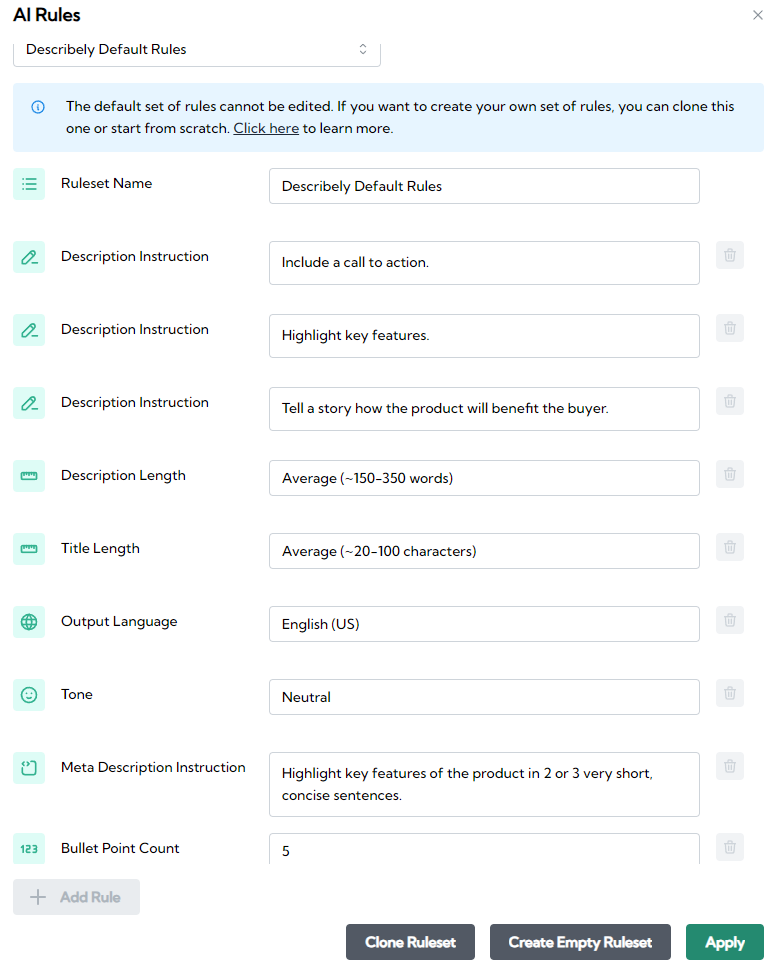
This way, when a platform like Amazon blacklists a new keyword, you can add a rule to remove it and bulk generate hundreds of revised listings in an instant.
How to Efficiently Write Good Product Descriptions Using AI For 500+ Listings
The best practices for eCommerce descriptions are only as useful as you can apply them. Some of them require ongoing monitoring, so unless you can update all listings quickly they’re not going to work. At best, you’re stuck on tedious, endless rewriting, as Jess commented:
“If I have to repeat an action over and over, that screams “inefficient”. If you have a growing product catalog, taking advantage of any and all bulk capabilities will reduce any frustration and get you results way faster.”
The Describely bulk generation allows you to, for example:
- Generate product descriptions from only titles
- Test product description examples by switching custom rulesets
- Select the descriptions or catalogs you want to change
- Partially regenerating content, such as only changing titles
Here’s a clothing store description example for bulk generation:

Not only can Describely write thousands of products, but it does it better the more you have, as Kyle said before:
“[…] a tool like Describely that automatically pulls context directly from your storefront.”
Additionally, an efficient AI tool allows you to organize product content in catalogs and rulesets for different brands. Then, you can selectively bulk-edit whichever listings are due for an update.
However, editing might mean changing five words but also rewriting half of the listing. If you want to avoid heavy editing, your best bet is an AI tool that’s designed to minimize the hurdles of writing a product description. And Describely helps eCommerce teams stick to the best practices by making them convenient, automated, and customized.
Finally, we asked Kyle and Jess the following:
Can AI Really Write Great Product Copy?
Both Kyle and Jess agree that product description generators are a powerful source of creativity, with plenty of AI use cases for eCommerce. As for the challenges described, only one remains. Kyle noted::
“[…] AI will make taxing work take a fraction of the time and help you scale, but AI isn’t perfect and requires you to guide it. Think of any AI tool as your partner, not your replacement – it performs best when you’re driving it. ”
To which Jess added:
“Recognize that you will most likely need to review your content before going live, so minimizing edits will save you time in the long run.”
AI can write great copy, but its consistency is correlated with the thoroughness of your instructions and revisions. And while you still need to guide the AI through your workflow, you can minimize the work with a specialized eCommerce AI tool. Sign up and try Describely today.


